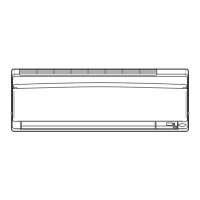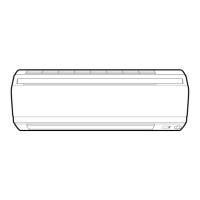How to stop Daikin Air Conditioner indoor unit from giving out odor?
- MMakayla AtkinsSep 3, 2025
If your Daikin Air Conditioner's indoor unit gives out an odor, it is recommended to have the indoor unit cleaned by a technician.

How to stop Daikin Air Conditioner indoor unit from giving out odor?
If your Daikin Air Conditioner's indoor unit gives out an odor, it is recommended to have the indoor unit cleaned by a technician.
Why is the cooling or heating effect poor in my Daikin Air Conditioner?
If the cooling or heating effect of your Daikin Air Conditioner is poor, check whether the air filters are clean.
How to stop the bad odor from my Daikin Air conditioning indoor unit?
If the indoor unit gives out an odor, it is recommended to have the indoor unit washed by a technician. Consult the service shop where you bought the air conditioner.
What to do if an abnormality (such as a burning smell) occurs with Daikin Air conditioning?
If an abnormality, such as a burning smell, occurs, turn the breaker OFF and call the service shop.
What to do if there is a burning smell coming from Daikin Air conditioning?
If you notice a burning smell, immediately turn the breaker OFF and call the service shop.
What to do if I hear an abnormal sound during Daikin Air conditioning operation?
If you hear an abnormal sound during operation, turn the breaker OFF and call the service shop.
Why is my Daikin Air Conditioner outdoor unit leaking water?
In HEAT mode, the frost on the outdoor unit melts into water or steam during defrost operation. In COOL or DRY mode, moisture in the air condenses into water on the cool surface of the outdoor unit piping and drips.
What to do if Daikin Air Conditioner operation stopped suddenly (OPERATION lamp is on)?
If the Daikin Air Conditioner operation stopped suddenly and the OPERATION lamp is on, it will automatically resume operation in about 3 minutes.
What to do if Daikin FTXS25CVMB operation stops suddenly and the OPERATION lamp flashes?
If the Daikin Air Conditioner operation stops suddenly and the OPERATION lamp flashes, clean the air filters or remove any obstructions. Then, turn the breaker OFF, turn it ON again, and try operating the air conditioner.
Why my Daikin Air conditioning operation does not start soon?
You should wait for about 3 minutes.
| Cooling Capacity | 2.5 kW |
|---|---|
| Heating Capacity | 3.2 kW |
| Energy Efficiency Ratio (EER) Cooling | 3.21 |
| Weight (Indoor Unit) | 8 kg |
| Type | Split System |
| Coefficient of Performance (Heating) | 4.0 |
| Refrigerant | R32 |
| Noise Level (Indoor Unit) | 19 dB (Low) |
| Noise Level (Outdoor Unit) | 48 dB(A) |
| Power Supply | 220-240V / 50Hz |
Covers general warnings, cautions, and specific safety instructions for safe operation.
Guidelines for choosing a suitable installation location to ensure proper function and safety.
Requirements for electrical connections and procedures for safely relocating the air conditioner unit.
Identification and description of the various parts of the indoor air conditioning unit.
Identification and description of the various parts of the outdoor air conditioning unit.
Identification and description of the buttons and display of the remote controller.
Step-by-step instructions for correctly inserting batteries into the remote controller.
Guidelines for operating the remote controller and fixing its holder on a wall.
Procedure for setting the internal clock for accurate timer functions.
Steps to start/stop the unit and adjust the temperature settings for comfort.
Explanations for HEAT, COOL, DRY, and AUTO operation modes and their characteristics.
How to change the fan speed settings for different operation modes.
Instructions for controlling the direction of airflow using horizontal blades (flaps).
Instructions for manually adjusting the direction of airflow using vertical louvers.
How to activate the powerful mode for quick cooling or heating effect.
How to reduce the noise level of the outdoor unit for quiet operation.
How to record and use personalized temperature and airflow settings.
Using the motion sensor for energy saving and adjusting its detection angle.
Setting ON and OFF timers for automatic unit control.
Guidelines for operating multiple indoor units connected to one outdoor unit.
How the priority room designation affects operation and feature control.
Instructions for cleaning the indoor and outdoor unit components.
Steps for cleaning and replacing air filters and photocatalytic deodorizing filters.
Essential checks before operation and steps for preparing the unit for long-term storage.
Explains common behaviors that are not actual malfunctions.
Steps to diagnose issues and interpret fault codes.
Situations requiring professional service and critical safety warnings.
How to interpret LED lights on the outdoor unit PCB for fault diagnosis.












